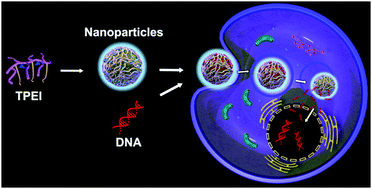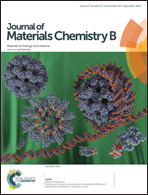Micelle-like luminescent nanoparticles as a visible gene delivery system with reduced toxicity†
Abstract
Cationic polymers have been widely used as promising non-viral gene carriers, but their undesirable toxicity is a drawback. Hydrophobic modification has been developed as an efficient strategy to overcome this disadvantage. In this study, 25 kDa polyethyleneimine (PEI), the gold standard of polycations for effective gene delivery, was modified with the hydrophobic luminogen tetraphenylethene (TPE), which shows aggregation-induced emission (AIE) and has been utilized as a luminescent probe in various applications. The modified PEI (TPEI) self-assembled into micelle-like nanoparticles (TPEI-NPs) and displayed AIE behavior in aqueous media. The TPEI-NPs exhibited bright blue fluorescence and were suitable for long-term cell imaging. Compared with PEI, TPEI-NPs showed lower cytotoxicity but the transfection efficiency was nearly high. Therefore, the modification of polycations with hydrophobic fluorescent molecules represents an advanced strategy for designing visible gene vehicles with low toxicity.


 Please wait while we load your content...
Please wait while we load your content...